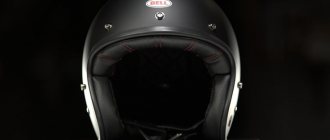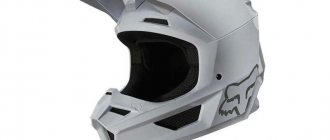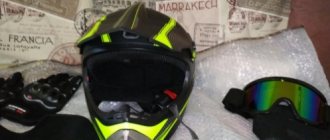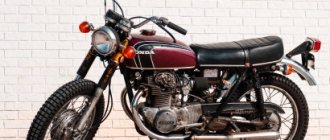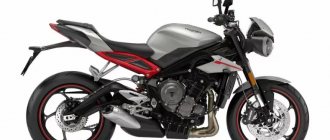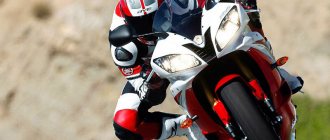Motorcycle helmet HJC RPHA 90
In general, I am lukewarm about modulars. Usually they fit well with the jaw open, but when closed they put treacherous pressure on my temples. At short distances you don’t even notice this, but as soon as you decide to move away from home, that’s when it begins... Have you ever found yourself far from home with a wild headache and a complete lack of choice on how to live? Even if not, you can imagine how disgusting it is.
HJC RPHA 70
We were able to try the new product for 2022 - the RPHA 70 helmet - in the city, in long-distance driving, and on the track. Maybe this is not yet a full-fledged resource test, but an opinion about this “safe hat” has already been formed, and I am ready to share it.
This helmet sunk into my soul after its presentation at the Koln Intermot - 2016 exhibition, where the company’s management enthusiastically said that they had managed to create a revolutionary product that could change people’s perceptions of full-face helmets. In short, we have to take it, which is what I did as soon as the first delivery arrived in Moscow.
The first trips took place when there was still snow on the roadsides, and they showed that without the pinlock that comes with the package, the visor sweats. I don’t really like putting a multi-layer sandwich of glass in front of my face, and I hoped that I would be able to avoid this this time, but no, I had to use a pinlock. Fortunately, it does not add optical distortion either along the axis or in peripheral vision: the picture does not float or double. The same can be said about the additional sun visor, which is pulled out by a slider on the chin on the left - the fact that it is pulled out is only reminded by its lower edge, which, on the one hand, is visible if you specifically lower your eyes downwards, but on the other hand, it does not cut the image of the road and dashboard in half.
A well-designed aerodynamic shape and the presence of a built-in dark visor make the RPHA-70 an excellent touring helmet - it is quiet, it does not flap in the wind even at high speeds, you do not need to carry a second glass with you, its visor fits tightly to the rubber gasket and is locked on the latch, excluding water leakage onto the inner surface of the glass, it has a standard pinlock. The standard niches opposite the ears are well soundproofed, and they already have Velcro, where the headset speakers fit perfectly. Music on the road can be heard clearly, and you can talk on the phone on the road without slowing down.
On the track and in the city on hot days, you gain respect for the work carried out by the engineers in organizing head ventilation. One central and two additional upper side air intakes allow you to drive with a dry and cool head even in hot weather. There, the shape is chosen in such a way that when bending down to the tank and lowering the head, the air flow in the grooves of the foam filler along the skin increases, and on the straights, all the heat generated during the passage of a series of slow turns is blown out through two “exhaust” ventilation windows on the back of the head, which are located in aerodynamic vacuum zone and are always open.
There are three ventilation windows on the chin. The top two send air along the visor from the inside and are designed to combat fogging, the bottom one, captured by a steel grill, sends air into the face so that there is something to breathe. This is where the tourism component of the helmet won out over the sports component. The filters that stand in the channels and fight dust and sand reduce their throughput, and even when the air intakes are fully open, there is a little lack of air. On a hot day at the track you have to remove the chin curtain, otherwise you start to suffocate. I'm thinking about opening up this assembly and making the filters thinner or removing them from the channels altogether.
The RPHA -70 helmet is suitable for owners of naked bikes, sportbikes and sports tourists - both in its characteristics and in its appearance it is ideal for this class of motorcycles. On chopper owners it will look overly modern. But I don’t recommend it to owners of full-fledged tourists and cruisers with a high glass or front fairing - in the aerodynamic shadow of the fairing, the front ventilation of the helmet will work poorly - you will have to fully open the visor in the heat so as not to overheat.
I chose a pearl white helmet for myself because it would be easier to brand. But for this model there are many interesting colors with well-developed color schemes. There is also a replica of the Iron Man color scheme in classic burgundy and gold – it’s just a masterpiece!
The helmet was provided for testing by the Mr. Moto salon,
https://www.mr-moto.ru Life with X4 > August 22, 2022 17:54 Denis DEAN Panferov
HJC RPHA-X SEEZE Helmet – REVIEW
text: Yuri Solonovich photo: Nikita Kolobanov
I have known the helmets of the Korean company HJC for a long time. While still a purely “asphalt” motorcyclist, wearing a “helmet” of this particular brand, I rode through the city streets on an ancient Yamaha FZR600. In principle, I was satisfied with absolutely everything about that helmet: from the “budget” price tag to the quite acceptable quality. But the company’s off-road models passed, as they say, “past me”... But today I have in my hands the latest Asian development - HJC RPHA-X.
In my opinion, the world of motorcycle helmets is divided into two eras: before the new Shoei VFX-W model (four years ago) and after. Its appearance turned out to be so successful that today, it seems, every second helmet is an almost exact copy of the Japanese original, and many manufacturers use very similar technical and design solutions when creating their products. It is not surprising that the HJC RPHA-X did not escape this fate either. For example, the back of the helmet is very similar to the Japanese prototype, and in the design of the front there are continental notes of another bestseller in the off-road market - the Airoh Aviator brand helmet. But in general, despite some external secondaryness, RPHA-X looks quite harmonious.
The new HJC is created from a composite material using PIM (Premium Integrated Matrix) technology: fiberglass plus carbon and aramid fibers. This solution made it possible to create a lightweight “shell” without loss of strength. When designing the helmet, engineers provided many ventilation channels laid directly into the body of the filler and lining. Traditionally, for helmets of this level, the internal “guts” are removable and machine washable. They are made of anti-allergenic material Cool4ever, which absorbs moisture well and is resistant to odors. The RPHA-X has a visor made of bendable (another hello from Shoei VFX!), but not brittle, abrasion-resistant plastic. Now, if you fall, you don’t need to worry about finding a spare part - nothing will happen to the visor!
A detailed examination showed that the helmet was made and assembled with very high quality: definitely no worse than the best Japanese and European models. And it also sits on your head very well: the HJC “helmet” weighs only 1100 g and does not allow your neck to get tired even after long enduro rides. With the rigid neck guards I use (Leatt Brace Adventure and EVS R4), the RPHA-X got along without any problems. I also really liked the color scheme of the model range: unlike other Asian manufacturers, everything is as bright and individual as possible, but without any arrogant bad taste. Among the shortcomings, I note that the Double Ring clasp located on the belt is too short and unfastening the helmet is not particularly convenient. The second drawback is the not very reliable mounting system for the visor. In my copy, the central mounting screw turned out to be too “frail” from the very beginning. But otherwise, despite my love for Japanese helmets, I really liked the HJC RPHA-X. Let's hope that during test use it will not present any unpleasant surprises.
Encyclopedia of helmets for road racing. 27 MODELS!
In all Russian racing series there is a section of the regulations regarding head protection. They traditionally specify that the helmet must have a one-piece shell construction (integral), have a strap fastener in the form of a double D-ring (D-ring), and have European certification ECE 22-05, (sometimes American SNELL is allowed). Behind the scenes of the formal requirements are effective ventilation, sophisticated aerodynamics, good visibility, and much more, which allows the athlete in the race to concentrate on aerobatics, without being distracted by a helmet that is not up to the task. And equipment manufacturers are happy to try, offering dozens of models to choose from, flaunting sophisticated technical solutions and extremely aggressive design. According to tradition, athletes get all the most expensive and pretentious things. After all, after watching the races on TV, hundreds of thousands of fans will run to the nearest dealer of the brand to buy a helmet like Lorenzo’s (Marquez, Rossi, Pedrosa, etc.). And no well-known manufacturer can afford to miss such a flow of customers (and cash). The bottom line is that we have a typical set of characteristics of a sports helmet, distinguishing it from urban and tourist helmets. Excellent ventilation. Often, urban riders suffer in top-end sports helmets, because intense air jets dry out their eyes (especially with lenses) and create a feeling of discomfort. Some of the presented helmets are inferior to the class leaders, but relative to, for example, tourist helmets, all the models presented in the review are in perfect order with this parameter. Light weight. Sports helmets are usually the lightest in the model range of any manufacturer. Only helmets certified simultaneously for several markets, as a rule, have a weight approaching 1500g. Since their developers have to provide a margin of safety for testing methods that are often fundamentally different from each other. Good review. In a race, unlike on city streets, upward visibility is extremely important. After all, an athlete should be able to navigate in space even when he is spread out on the motorcycle, with his chin buried in the tank. Therefore, with each new generation of sports helmets, the upper edge of the visor rises higher and higher. As for the side view, in racing helmets it is often blocked by the lower edge of the visor raised up. Sophisticated aerodynamics. If at 300 km/h. your helmet begins to mercilessly chatter with the air flow - this is a big problem. At such speeds, even the presence and shape of the aerodynamic hump on the overalls plays a very important role. Removable, quick-drying lining with antibacterial coating. Motorsport is a discipline with a high level of physical activity. Many racers sweat intensely due to their metabolism. Sometimes the races themselves take place in southern countries, and even during the hot season. In any case, moisture must be quickly removed, and the insides must be removable so they can be washed. Emergency side packing removal system. Makes it easier to remove the helmet if the pilot is injured. Reduces the risk of additional injuries to the damaged cervical spine. Allows you to pull out the side padding of the helmet in one motion, and then begin to remove the helmet. Currently installed on most helmets, and not only sports ones.
Myths about sports helmets.
Myth No. 1.
Top sports helmets are the safest. All helmets officially sold in European countries comply with the same ECE 22-05 certificate and have the same high level of safety. Attempts in some countries to introduce an independent rating system (for example, SHARP in the UK) only make it possible to divide obviously safe helmets into slightly more and slightly less safe ones. And at the same time, budget models from affordable manufacturers (for example, Lazer LZ6) often receive the highest rating - *****, while not all top sports models from premium brands can boast of this.
Myth No. 2.
The composite shell of sports helmets protects the head better than the thermoplastic shell of mass-produced civilian models. As already mentioned, all helmets in our stores undergo the same tests as part of certification. And the composite shell of sports helmets only allows you to lose a couple of hundred grams, forcing the buyer to pay with a noticeable increase in cost. In addition, a composite shell loses more strength when impacted by hard objects, as the composite can delaminate and lose structural integrity at the point of impact.
Myth No. 3.
A top-end sports helmet is the best choice for public roads. Unfortunately, racing helmets tend to be quite noisy. The mediocre side visibility of some models does not always allow you to freely navigate in dense traffic. And ventilation may seem excessive to many. In addition, the aerodynamics of such helmets are worked out based on the shrimp pose, which no one in their right mind would try to assume on naked bikes, tourists and enduros. And the developed aerodynamic elements of such helmets can become a source of noise and vibration on touring motorcycles if they are exposed to a swirling air flow from a large windshield.
Below is information about the vast majority of racing helmets worn by world and national championship riders. Some models are not presented in Russia for various reasons, but they can be ordered without problems at foreign online auctions. Most of them regularly become participants in tests and reviews of the world's leading motorcycle media with huge circulations and audiences. It is the results of these tests, along with the personal experiences of Russian journalists and athletes, that formed the basis of this review. In any case, it is hardly worth treating this material as a final verdict. Rather, as an attempt to combine existing information and invite people with their own views based on real experience to discuss this topic.
